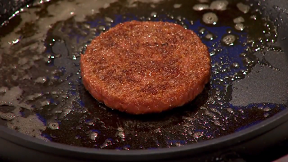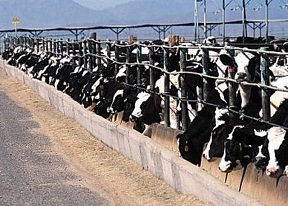The Dutch site sciencelink.net recently devoted its attention to cultured meat. Not 100% vegetarian; for the instruction for meat production must be derived from a code derived from animals. But even so: it has great potential to substitute for ‘animal’ meat. How are the odds?

Consumer is decisive
We all know vegetal meat substitutes. Popular in the supermarket, although sales are still modest. A growing number of people is flexitarian: at times they eat meat, at times meat substitutes. Will cultured meat convince them? In ten years’ time, we will know the answer; as cultured meat will enter the market, and can be judged by consumers on taste and price. Potentially, sciencelink.net writes, there are major advantages to cultured meat. In terms of animal suffering, environmental pollution and food safety, cultured meat far outperforms the real stuff. Will that be sufficient to convince consumers? And what part will price play in such a comparison?
The cultured hamburger hasn’t even lived through its first decade yet. The first one was served on August 5, 2013, to food specialist Hanni Rützer, live on British television. Its taste was all right, she judged, even though it was a bit dry. Its price wasn’t right yet: € 250,000. Right now, the cultured burger isn’t for sale yet. First of all, the production process should be judged by European rule makers – and the European Authority for Food Safety (EFSA) has not yet decided on the criteria on which cultured meat should be judged. But in Singapore they already sell cultured chicken meat from 2021 onwards, produced by the American company Eat Just.
The advantages of cultured meat
What are cultured meat’s advantages? First of all: we need less animals, far less even. We can produce cultured meat from animal stem cells. We can obtain these for instance from a cow, through a muscular punction under local anaesthesia. According to Mosa Meat, the Dutch artificial meat company, one such punction will allow us to grow 80,000 hamburgers. We already signalled that cultured meat is not entirely animal-free. But there is a major difference with animal meat. If we slaughter a cow, it will serve us just about 3,000 portions.

There are more differences with animal meat. We don’t have to kill the animal in order to consume meat, and that reduces very much animal suffering. Compared to meat from factory farming, cultured meat has a much lower environmental footprint: we need less land, water and animal feed. We will produce a lot less greenhouse gases – carbon dioxide and of course methane, produced by the cow as it belches. Food safety and health aspects of cultured meat have better scores. We don’t need any antibiotics during production. Ad if we don’t use the cow as a source of meat, there is less danger of any disease transfer from cow to humans. But as said before, the all-important success factor of cultured meat will be the consumer’s judgement. Will the consumer soon move away from the steak and rather consume the cultured alternative?
How do we produce cultured meat?
Beef consists of the animal’s muscular tissue, a bundle of muscles. Filled with myofibrils, long protein chains that can contract. Moreover, it consists of nerves (allowing the muscle to contract when instructed to do so by the brain) and blood vessels, that supply the muscle with food and oxygen. The muscle is packed in protective connective tissue; and tendons connect the muscle to the skeleton. In between the muscular tissue is fatty matter. Muscular and fatty cells determine structure and taste of the meat. Living creatures produce both from stem cells.
But if we retrieve stem cells from a cow, we get just a few of them. They need to reproduce first. We culture them in bioreactors – separately so far, maybe jointly in the near future. Those reactors are fed with all growth factors, signalling molecules, other proteins and feed required for the cells to grow. The bioreactor should also deliver the signal that the stem cells should develop into muscular or fatty cells, at the right time.
From cells to tissue
Until recently, we grew stem cells in a medium containing fetal bovine serum, FBS. But that method was expensive and it harmed animals. Mosa meat researched alternatives and decided in 2021 to publish its results, in order to promote further research into cultured meat. Of particular importance is the right timing of the signal to stem cells to develop into muscular cells. Each animal requires a growth medium of its own. Even different cow races require a medium of their own.
In the end we are being supplied with many cells; but together, these do not yet add up to meat. For this purpose, the body contains an extracellular matrix (ECM) that lends structure and firmness to tissue. Thanks to ECM, sciencelink.net writes, ‘a cell can observe its environment, emit and receive signals, migrate and differentiate. Stem cells ‘listen’ so to speak to directives from the matrix.’ But of course, we also need to take care of the other determinants of growth, like blood supply; required for the supply to the cells of feed and oxygen.
From tissue to plate
Development of cultured meat is now shaping up. Decisive for the eventual success are structure and taste. As we master that art, we can start thinking of producing different kinds of meat. Meat of different animals; with properties resembling those of different parts of the body; products with the properties of fish. All this much resembles the development of other animal-free products – like cheese and leather.
But will there be a consumer market for these products, sciencelink.net wonders. Yes, there may be. Many people are interested in what such pathways may carry us. Of course, if in due time the price will be right – and that will require scaling up, which for its part requires falling prices. But still, we might find our way out of this chicken-and-egg story. Proponents of cultured meat point to subsidies to factory farming. These reduce meat’s cost price; and adds to the hill that cultured meat will have to climb. But innovation history proves: everything is doable. After all, cultured meat is already being sold in Singapore.
Interesting? Then also read:
New protein sources will fill the gap
Towards new agricultural practices
A plant-based diet would have a major impact on climate change
